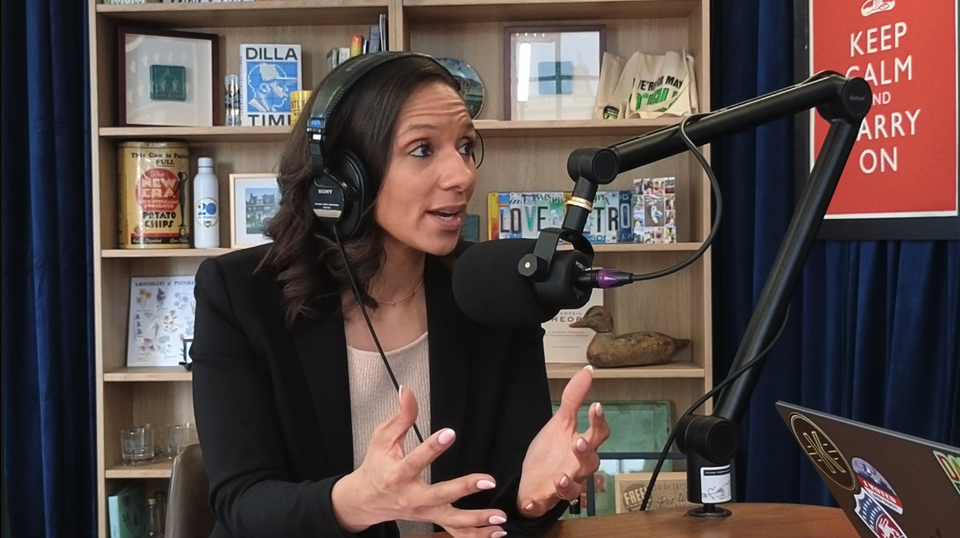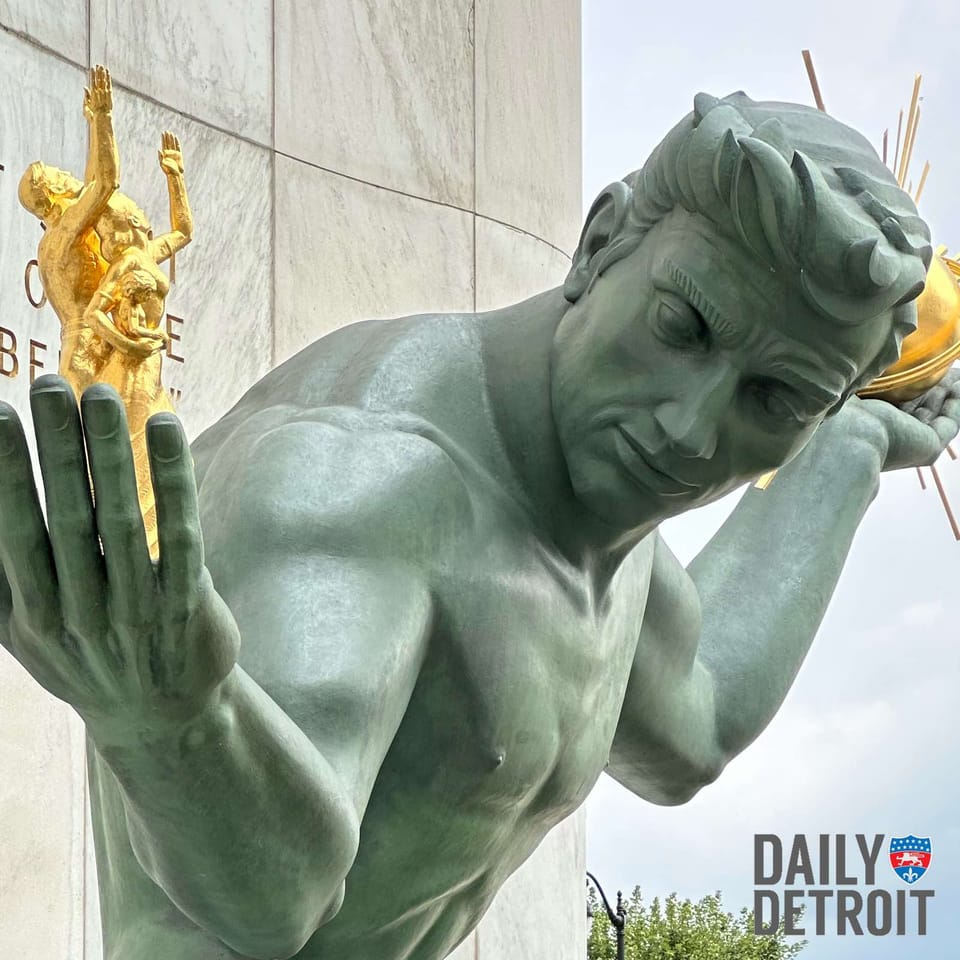Detroit is going through a lot of change. But what does that change look like? What will it look like in the future?
There are a lot of questions about what these changes mean for the city, its residents and our Detroit region. Many stakeholders are interested in Detroit’s turnaround, both private and public, and many in the community aren’t sure what the key players are interested in or what they want to do.
One of those key players is the Kresge Foundation, founded in 1924, a $3.5 billion, private, national foundation focused on cities. They’ve been a part of many major and minor developments in Detroit, whether they be physical, educational or cultural.
Examples of areas they focus on locally are arts and culture, education reform, growing small business, the green economy, health issues, mass transit, neighborhoods, land use and the Woodward creative corridor.

Earlier this summer at the Mackinac Policy Conference we had the opportunity to sit for an extended interview on the porch with Kresge Foundation President & CEO Rip Rapson to talk about the future of Detroit and the role of philanthropy in that future.
So fair warning: Although this post is longer than our usual, if you’re interested in Detroit’s turnaround, it’s worth the read.
Daily Detroit: You opened your speech to the businesspeople and policymakers here talking about New Detroit. What is new Detroit? Some people might not, outside of this porch on Mackinac Island, quite know what you mean by the “New Detroit,” especially in relation to the fact that there are so many Detroiters who’ve been here for a long time. They’re not sure what “New Detroit” means or if that includes them.
Rip Rapson: I think it’s a vitally important point. I think New Detroit, I think is the reset moment. It’s not that we need to reset with new residents. It’s not that we need to reset our legacy or our fundamental identity, but it’s a chance to reset the basic systems that we need to have in place in order to realize the full potential of a recovery.
So one of the things I tried to do in my talk was to lay out how I think the new Detroit combines the best of the old Detroit and the possibilities of a reinvented early childhood system. A reinvented transit system, a reinvented land use system. I think it was a call for all sectors of Detroit. Neighborhoods, downtown businesses, public sector, philanthropic sector to get together to figure out how to position the community for long term health and stability.
I think New Detroit, I think is the reset moment. It’s not that we need to reset with new residents. It’s not that we need to reset our legacy or our fundamental identity, but it’s a chance to reset the basic systems that we need to have in place in order to realize the full potential of a recovery.
Daily Detroit: When you talk about “New Detroit,” one of the first things that comes to mind was mass transit because we haven’t had really a cohesive working arrangement between DDOT (the city of Detroit system), SMART (the suburban system), and the others. You talk about “leaning in” to certain things and one of those being transit. Does that include dollars? What kind of support are you talking about when you say you’re going to “lean in” to something like [transit]?
Rip Rapson: I think you’re the only one who picked up on that term. Which is an important term because I think lean in can mean multiple things.
One is that, yes, we will invest dollars. We will continue to support the M-1 [Rail] project, because in many ways it stands at the core of a seamless regional transit system. It not only connects all parts of Detroit’s community, it really sets the frame for the broader regional system. The bus rapid transit system will have to play off of it. The Amtrak regional commuter system will have to play off of it. We’ll invest in the rail project even above and beyond what we’ve already invested.
Second, it seems to me that we have to continue invest in the engagement of communities about what transit means. We’ll continue to invest in MOSES and in Transit Riders United and other folks who are trying to make sure as we build out this new system of moving through our region that folks who will benefit from it and who may need its services the most have voice and can really weigh in on what that system would look like.
Third, is we’ve got to put in place a way of bringing these different pieces of the system together. We have to have a regional transit authority that works. It’s got to touch the Detroit bus system, it’s got to touch the rapid bus system, it’s got to figure out ways to make those things seamlessly connected. That’s a big lift, because all of a sudden that involves politics, it involves referenda, it involves county politics.
It’s a web of complexity that I think philanthropy can help with. Is that going to take one form specifically or another? I don’t know, but we need to help the new Regional Transit Authority get up and off the ground. We need to make sure it has the resources it needs to plan correctly. I think we need to invest in helping the public understand what the possibilities are. I think there’s a long list of ways in which we can invest and will invest.
Daily Detroit: When it comes to keeping talent in our region, one of things that I also thought was interesting is talking about edgier cases. Talking about different ways of investing in the community, especially because entrepreneurship is a big reason why a lot of young people come to the region. It’s the opportunities. I can’t tell you how many interviews we’ve done at Daily Detroit with people from New York, from Chicago, you name. It was that opportunity of entrepreneurship that really opened the door to the city, not as much as a traditional job per se, but the chance to “make my own thing.” What are the ways that you see your work supporting entrepreneurship? Those edgier kind of things and that middle ground.
A metaphor, if you will. In the biosphere, the most interesting and the most action happens at the intersection of the spheres of the land and the water. We see a kind of biosphere, but instead of land and water as the spheres, it’s philanthropy and business and the community. How do you see what you’re doing play into that?
Rip Rapson: That’s probably as complex a question as I ever been asked. It was wonderful. The analysis was terrific.
I think philanthropy can do two or three things.
One, six or seven years ago we had the idea that if we could create a pool of dollars that would help create, or at least reinforce an entrepreneurial ecology, that would be an important play to make. That rather than creating a new venture fund for health devices, or tech devices that what we could do to create training and support and maybe a little bit of angel investing at the front end. To try to get an ecology of entrepreneurship and small business growth more deeply embedded in the community, that fund was called the New Economy Initiative. We put $130 million into it among 10 different foundations.
I think it’s really paid off. I think when it combines with things like Bizdom U and some of the more recent small business development, [that] Chase [Bank] and Goldman [Sachs] have done. I think you’re beginning to see the kind of capitol fluidity these small businesses needs because I think you’re right. That if folks from New York, or San Francisco, or Memphis choose to come to Detroit, or for that matter use it as a reason to stay here in Detroit, start a business, grow a business and really claim their slice of the new economy, it’s got to be sustained.
There have got be ways in which they can continue to get capitol, they can have access to the right suppliers, they can move around the region properly. Again, what you need is a system. Philanthropy has done a pretty good job of that.
Kresge, particularly, is interested in exactly that kind of biosphere question you asked. What happens when you think about the natural environment. I don’t mean it quite so literally but sort of as a business opportunity. There’s green infrastructure, there are food systems, there’s reclamation of abandoned properties that can be re-purposed for arts and cultural activities. It’s really endless.
Not all of those are business propositions but a lot of them are. A lot of them, even if they’re not profit-making ventures, have all of the same qualities of small business. You’re trying an idea, you’re trying to grow it, you’re trying to make it sustainable, you’re trying to use it to build community.
Second thing that philanthropy can do is to invest in both the larger scale and the smaller scale reclamations of abandoned and blighted land.
Third, we just need to support small business. We need to figure out how do we make sure that some of these businesses who have a good idea have enough capital to get their legs out from under them. At some point they can go to market, at some point it may not work, at some point they may move on, but I think we can provide and support to small businesses to help get them up and going.
Daily Detroit: Finally, what is it when we talk to you on this porch next year that you want to be able to tell us happened between this talk and the next talk a year from now with you, what’s your wish list of accomplishments?
Rip Rapson: First is that we will have in place the outlines of an effective and accountable early childhood development system. We’ve just got to get early childhood right. It’s not burdened with all of the same politics as the K-12 system that I hope will get fixed, but Kresge is really going to put a stake in the ground, particularly with the Kellogg Foundation, and PNC Bank and a couple of others to really make sure that every kid in the city of Detroit inner school are ready to learn. That’s a little bit of rhetoric, but I think you can get the system in place that suggests how that will be done.
Second, by this time next year we really need to have made progress on the Regional Transit Authority. We need to have begun building a public information campaign. We need to have the infrastructure. We need to have the outlines of what the system will look like and how it will benefit the communities that we care about.
Third, I think I would really hope that from a year from now we will see a much larger corral of really interesting, edgy projects coming out of neighborhoods. They have the passion to do this. They have the capacity to do it. We’ve gotta figure out ways to support that energy. Whether it’s in conversion of land, or whether it’s arts and culture projects, or whether it’s in small pop up retail along our neighborhood commercial corridors. I would really hope that we can see a material difference in the level of activity and energy when we come back here next year.

















